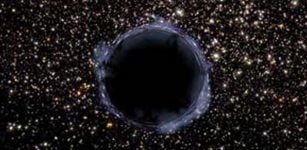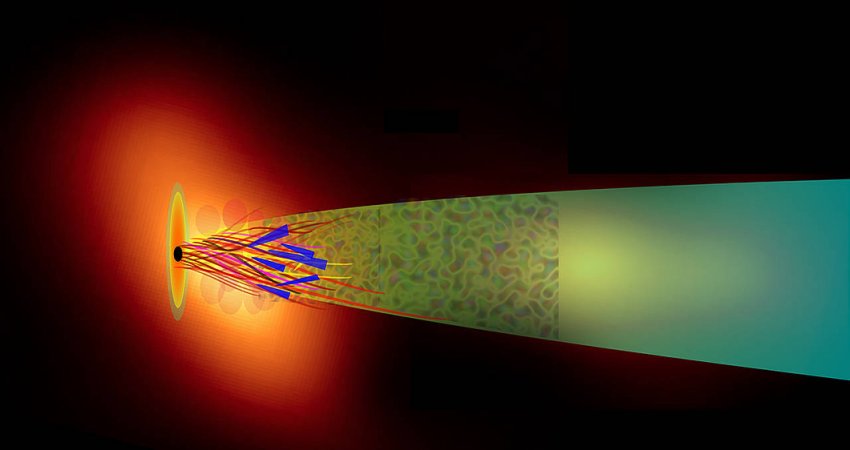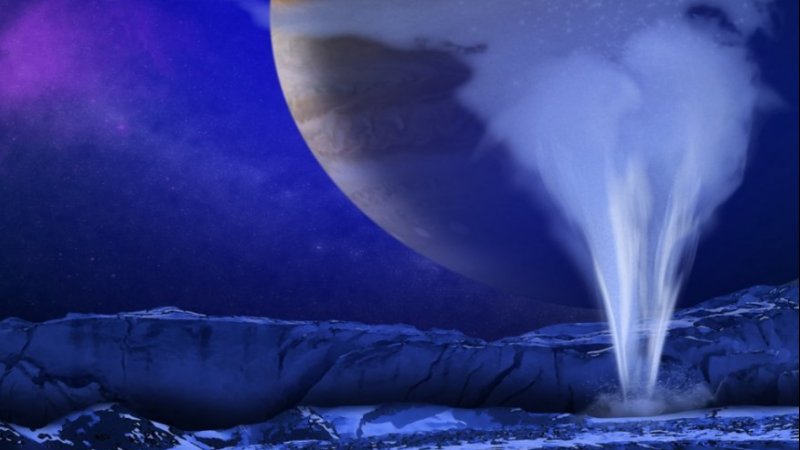Furthest Ever Detection Of A Galaxy Magnetic Field
Eddie Gonzales Jr. – MessageToEagle.com – Astronomers have detected the magnetic field of a galaxy so far away that its light has taken more than 11 billion years to reach us, providing astronomers with vital clues about how the magnetic fields of galaxies like our own Milky Way came to be.
This image shows the orientation of the magnetic field in the distant 9io9 galaxy, seen here when the Universe was only 20% of its current age — the furthest ever detection of a galaxy’s magnetic field. The observations were done with the Atacama Large Millimeter/submillimeter Array (ALMA), in which ESO is a partner. Dust grains within 9io9 are somewhat aligned with the galaxy’s magnetic field, and due to this they emit polarised light, meaning that light waves oscillate along a preferred direction rather than randomly. ALMA detected this polarisation signal, from which astronomers could work out the orientation of the magnetic field, shown here as curved lines overlaid on the ALMA image.
The polarised light signal emitted by the magnetically aligned dust in 9io9 was extremely faint, representing just one percent of the total brightness of the galaxy, so astronomers used a clever trick of nature to help them obtain this result. The team was helped by the fact that 9io9, although very distant from us, had been magnified via a process known as gravitational lensing. This occurs when light from a distant galaxy, in this case 9io9, appears brighter and distorted as it is bent by the gravity of a very large object in the foreground. Credit: ALMA (ESO/NAOJ/NRAO)/J. Geach et al.
The discovery was made in a study led by James Geach, Professor of Astrophysics at the University of Hertfordshire, using the Atacama Large Millimeter/submillimeter Array (ALMA) in partnership with the European Southern Observatory (ESO). It is the most distance ever detection of a galaxy’s magnetic field – so far away that we see it as it was when the Universe was just 2.5 billion years old.
Lots of astronomical bodies in the Universe have magnetic fields, whether it be planets, stars or galaxies: “Many people might not be aware that our entire galaxy and other galaxies are laced with magnetic fields, spanning tens of thousands of lightyears,” says Professor Geach. However, it is not clear how early in the lifetime of the Universe, and how quickly, magnetic fields in galaxies were formed – because up to now, astronomers have only been able to map magnetic fields in galaxies close to us.
Now, using ALMA, Professor Geach and his team have identified a fully-formed magnetic field in a distant galaxy, about 1000 times weaker than the Earth’s magnetic field but extending over more than 16,000 lightyears.
Observing a fully developed magnetic field this early in the history of the Universe indicates that magnetic fields spanning entire galaxies can form rapidly, while young galaxies are still growing. “This discovery gives us new clues as to how galactic-scale magnetic fields are formed,” explains Professor Geach.
The team believes that intense star formation in the early Universe could have played a role in accelerating the development of the fields. Moreover, these fields can in turn influence how later generations of stars will form.
According to co-author and ESO astronomer Rob Ivison, “The discovery opens up a new window onto the inner workings of galaxies, because the magnetic fields are linked to the material that is forming new stars”.
To make this detection, the team searched for light emitted by dust grains in a distant galaxy called 9io9[1]. Galaxies are packed full of dust grains and, when a magnetic field is present, the grains tend to align and the light they emit becomes polarised. This means that the light waves oscillate along a preferred direction, rather than randomly. When ALMA detected and mapped a polarised signal coming from 9io9, the research team were able to confirm the presence of a magnetic field in a very distant galaxy for the first time. “No other telescope could have achieved this,” says Professor Geach.
Scientists hope that with this and future observations of distant magnetic fields, the mystery of how these fundamental galactic features form will begin to unravel.
‘Polarized thermal emission from dust in a galaxy at redshift 2.6’ is published in Nature on 6 September 2023. For more information on astrophysics research at Herts, visit herts.ac.uk.
[1]9io9 was discovered in the course of a citizen science project. The discovery was helped by viewers of the British BBC television programme Stargazing Live, when over three nights in 2014 the audience was asked to examine millions of images in the hunt for distant galaxies.This image shows the orientation of the magnetic field in the distant 9io9 galaxy, seen here when the Universe was only 20% of its current age — the furthest ever detection of a galaxy’s magnetic field. The observations were done with the Atacama Large Millimeter/ submillimeter Array (ALMA), in which ESO is a partner. Dust grains within 9io9 are somewhat aligned with the galaxy’s magnetic field, and due to this they emit polarised light, meaning that light waves oscillate along a preferred direction rather than randomly. ALMA detected this polarisation signal, from which astronomers could work out the orientation of the magnetic field, shown here as curved lines overlaid on the ALMA image.
The polarised light signal emitted by the magnetically aligned dust in 9io9 was extremely faint, representing just one percent of the total brightness of the galaxy, so astronomers used a clever trick of nature to help them obtain this result. The team was helped by the fact that 9io9, although very distant from us, had been magnified via a process known as gravitational lensing. This occurs when light from a distant galaxy, in this case 9io9, appears brighter and distorted as it is bent by the gravity of a very large object in the foreground.
Written by Eddie Gonzales Jr. – MessageToEagle.com Staff











